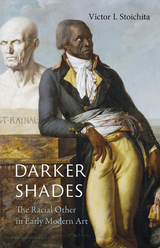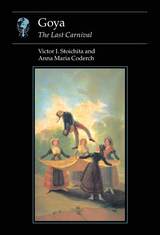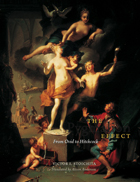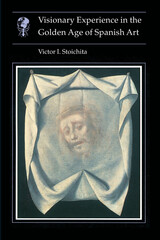5 books about Stoichita, Victor I.

Darker Shades
The Racial Other in Early Modern Art
Victor I. Stoichita
Reaktion Books, 2019
Difference exists; otherness is constructed. This book asks how important Western artists, from Giotto to Titian and Caravaggio, and from Bosch to Dürer and Rembrandt, shaped the imaging of non-Western individuals in early modern art. Victor I. Stoichita’s nuanced and detailed study examines images of racial otherness during a time of new encounters of the West with different cultures and peoples, such as those with dark skins: Muslims and Jews. Featuring a host of informative illustrations and crossing the disciplines of art history, anthropology, and postcolonial studies, Darker Shades also reconsiders the Western canon’s most essential facets: perspective, pictorial narrative, composition, bodily proportion, beauty, color, harmony, and lighting. What room was there for the “Other,” Stoichita would have us ask, in such a crystalline, unchanging paradigm?
[more]

Goya
The Last Carnival
Victor Stoichita
Reaktion Books, 1999
This intriguing book on Goya concentrates on the closing years of the eighteenth century as a neglected milestone in his life.
Goya waited until 1799 to publish his celebrated series of drawings, the Caprichos, which offered a personal vision of the "world turned upside down". Victor I. Stoichita and Anna Maria Coderch consider how themes of Revolution and Carnival (both seen as inversions of the established order) were obsessions in Spanish culture in this period, and make provocative connections between the close of the 1700s and the end of the Millennium. Particular emphasis is placed on the artist's links to the underground tradition of the grotesque, the ugly and the violent. Goya's drawings, considered as a personal and secret laboratory, are foregrounded in a study that also reinterprets his paintings and engravings in the cultural context of his time.
Goya waited until 1799 to publish his celebrated series of drawings, the Caprichos, which offered a personal vision of the "world turned upside down". Victor I. Stoichita and Anna Maria Coderch consider how themes of Revolution and Carnival (both seen as inversions of the established order) were obsessions in Spanish culture in this period, and make provocative connections between the close of the 1700s and the end of the Millennium. Particular emphasis is placed on the artist's links to the underground tradition of the grotesque, the ugly and the violent. Goya's drawings, considered as a personal and secret laboratory, are foregrounded in a study that also reinterprets his paintings and engravings in the cultural context of his time.
[more]

The Pygmalion Effect
From Ovid to Hitchcock
Victor I. Stoichita
University of Chicago Press, 2008
Between life and the art that imitates it is a vague, more shadowy category: images that exist autonomously. Pygmalion’s mythical sculpture, which magnanimous gods endowed with life after he fell in love with it, marks perhaps the first such instance in Western art history of an image that exists on its own terms, rather than simply imitating something (or someone) else. In The Pygmalion Effect, Victor I. Stoichita delivers this living image—as well as its many avatars over the centuries—from the long shadow cast by art that merely replicates reality.
Stoichita traces the reverberations of Ovid’s founding myth from ancient times through the advent of cinema. Emphasizing its erotic origins, he locates echoes of this famous fable in everything from legendary incarnations of Helen of Troy to surrealist painting to photographs of both sculpture and people artfully posed to simulate statues. But it was only with the invention of moving pictures, Stoichita argues, that the modern age found a fitting embodiment of the Pygmalion story’s influence. Concluding with an analysis of Alfred Hitchcock films that focuses on Kim Novak’s double persona in Vertigo, The Pygmalion Effect illuminates the fluctuating connections that link aesthetics, magic, and technical skill. In the process, it sheds new light on a mysterious world of living artifacts that, until now, has occupied a dark and little-understood realm in the history of Western image making.
[more]

Short History of the Shadow
Victor Stoichita
Reaktion Books, 1999
Stoichita's compelling account untangles the history of one of the most enduring challenges to beset Western art - the depiction and meanings of shadows.
"discriminating, inspired interrogation ... dazzling analysis"—Marina Warner, Tate Magazine
"Ambitious and a pleasure to read ... a thoroughly worthwhile book."—Times Higher Education Supplement
"discriminating, inspired interrogation ... dazzling analysis"—Marina Warner, Tate Magazine
"Ambitious and a pleasure to read ... a thoroughly worthwhile book."—Times Higher Education Supplement
[more]

Visionary Experience in the Golden Age of Spanish Art
Victor Stoichita
Reaktion Books, 1995
In this original and lucid account of how Spanish painters of the 16th and 17th centuries dealt with mystic visions in their art, and of how they attempted to "represent the unrepresentable", Victor Stoichita aims to establish a theory of visionary imagery in Western art in general, and one for the Spanish Counter-Reformation in particular. He reveals how the spirituality of the Counter-Reformation was characterized by a rediscovery of the role of the imagination in the exercise of faith. This had important consequences for painters such as Velazquez, Zurbaran and El Greco, leading to the development of ingenious solutions for visual depictions of mystical experience. This was to crystallize into an overtly meditative and didactic pictorial language.
That Spanish painting is both cerebral and passionate is due to the particular historical forces which shaped it. Stoichita's account will be of crucial interest not just to scholars of Spanish art but to anyone interested in how art responds to ideological pressures.
That Spanish painting is both cerebral and passionate is due to the particular historical forces which shaped it. Stoichita's account will be of crucial interest not just to scholars of Spanish art but to anyone interested in how art responds to ideological pressures.
[more]
READERS
Browse our collection.
PUBLISHERS
See BiblioVault's publisher services.
STUDENT SERVICES
Files for college accessibility offices.
UChicago Accessibility Resources
home | accessibility | search | about | contact us
BiblioVault ® 2001 - 2024
The University of Chicago Press









